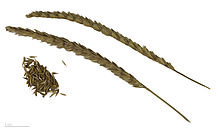Associations
provided by BioImages, the virtual fieldguide, UK
Foodplant / saprobe
pycnidium of Ascochyta coelomycetous anamorph of Ascochyta cynosuricola is saprobic on dead, dry sheath of Cynosurus cristatus
Remarks: season: 8
Foodplant / saprobe
pycnidium of Ascochyta coelomycetous anamorph of Ascochyta subalpina is saprobic on dead leaf of Cynosurus cristatus
Remarks: season: 6-8
In Great Britain and/or Ireland:
Foodplant / parasite
Blumeria graminis parasitises live Cynosurus cristatus
Foodplant / spot causer
colony of Mastigosporium anamorph of Mastigosporium album causes spots on leaf of Cynosurus cristatus
Foodplant / parasite
telium of Puccinia graminis ssp. graminicola parasitises live sheath of Cynosurus cristatus
Foodplant / spot causer
immersed stromatic of Rhynchosporium coelomycetous anamorph of Rhynchosporium secalis causes spots on live sheath of Cynosurus cristatus
Comments
provided by eFloras
This species is introduced in some temperate countries as a pasture and lawn grass and is adventive elsewhere.
- license
- cc-by-nc-sa-3.0
- copyright
- Missouri Botanical Garden, 4344 Shaw Boulevard, St. Louis, MO, 63110 USA
Description
provided by eFloras
Perennial, compactly tufted. Culms wiry, erect or decumbent at base, 20–70 cm tall, 1–2 mm in diam., unbranched, 3–4-noded. Leaf sheaths smooth, glabrous; leaf blades up to 15 cm × 1–4 mm, soft, smooth, glabrous, apex finely acute; ligule 0.5–1.5 mm, rounded. Panicle linear-oblong, spikelike, 5–10 × 0.5–0.7 cm, erect or slightly curved; branches very short. Fertile spikelet oblong or wedge-shaped, 3–6 mm, florets 2–5; glumes lanceolate, shorter than florets, 3–4.5 mm, margins membran-ous, back keeled, keel scabrid, apex acuminate or mucronate; lemmas narrowly ovate-oblong, lowest ca. 4 mm, spinescent, apex mucronate; palea slightly shorter than lemma, keels scabrid. Anthers ca. 2 mm. Caryopsis oblong, ca. 2 mm, apex glabrous. Sterile spikelet ovate, composed of up to 18 stiff, narrowly linear, shortly awned empty lemmas with green ciliate keel. Fl. and fr. Jun–Aug. 2n = 14.
- license
- cc-by-nc-sa-3.0
- copyright
- Missouri Botanical Garden, 4344 Shaw Boulevard, St. Louis, MO, 63110 USA
Habitat & Distribution
provided by eFloras
Roadsides, forest margins, fields, adventive. Jiangxi (Lu Shan) [N Africa, SW Asia, Europe; introduced in North America and Australia].
- license
- cc-by-nc-sa-3.0
- copyright
- Missouri Botanical Garden, 4344 Shaw Boulevard, St. Louis, MO, 63110 USA
Physical Description
provided by USDA PLANTS text
Perennials, Terrestrial, not aquatic, Stems nodes swollen or brittle, Stems erect or ascending, Stems caespitose, tufted, or clustered, Stems terete, round in cross section, or polygonal, Stem internodes hollow, Stems with inflorescence less than 1 m tall, Stems, culms, or scapes exceeding basal leaves, Leaves mostly cauline, Leaves conspicuously 2-ranked, distichous, Leaves sheathing at base, Leaf sheath mostly open, or loose, Leaf sheath smooth, glabrous, Leaf sheath or blade keeled, Leaf sheath and blade differentiated, Leaf blades linear, Leaf blades 2-10 mm wide, Leaf blades mostly flat, Leaf blades mostly glabrous, Ligule present, Ligule an unfringed eciliate membrane, Inflorescence terminal, Inflorescence a contracted panicle, narrowly paniculate, branches appressed or ascending, Inflorescence a dense slender spike-like panicle or raceme, branches contracted, Inflorescence solitary, with 1 spike, fascicle, glomerule, head, or cluster per stem or culm, Inflorescence densely corymbose, paniculate, or capitate, rays reduced or absent, Inflorescence single raceme, fascicle or spike, Flowers bisexual, Spikelets sessile or subsessile, Spikelets laterally compressed, Spikelet less than 3 mm wide, Spikelets with 2 florets, Spikelets with 3-7 florets, Spikelets solitary at rachis nodes, Pedicellate spikelet rudimentary or absent, usually sterile, Spikelets bisexual, Spikelets disarticulating above the glumes, glumes persistent, Spikelets in dense head-like clusters, Spikelets secund, in rows on one side of rachis, Rachilla or pedicel glabrous, Glumes present, empty bracts, Glumes 2 clearly present, Glumes equal or subequal, Glumes shorter than adjacent lemma, Glumes 1 nerved, Lemma coriaceous, firmer or thicker in texture than the glumes, Lemma 5-7 nerved, Lemma glabrous, Lemma apex truncate, rounded, or obtuse, Lem ma mucronate, very shortly beaked or awned, less than 1-2 mm, Lemma margins thin, lying flat, Lemma straight, Palea present, well developed, Palea membranous, hyaline, Palea longer than lemma, Stamens 3, Styles 2-fid, deeply 2-branched, Stigmas 2, Fruit - caryopsis.
Cynosurus cristatus: Brief Summary
provided by wikipedia EN

Cynosurus cristatus -
MHNT Cynosurus cristatus, the crested dog's-tail, is a short-lived perennial grass in the family Poaceae, characterised by a seed head that is flat on one side. It typically grows in species rich grassland. It thrives in a variety of soil types but avoids the acid and calcareous extremes of pH, and prefers well drained soils. It may be grown as an ornamental plant.
- license
- cc-by-sa-3.0
- copyright
- Wikipedia authors and editors




 Cynosurus cristatus - MHNT
Cynosurus cristatus - MHNT